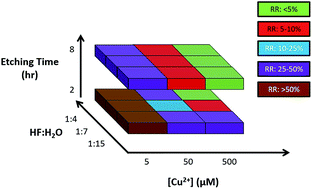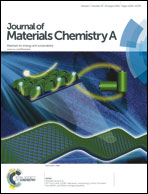Anti-reflection layers fabricated by a one-step copper-assisted chemical etching with inverted pyramidal structures intermediate between texturing and nanopore-type black silicon
Abstract
A new one-step copper-assisted chemical etching technique is reported to more economically prepare nanopore-type anti-reflective layers, which can effectively suppress reflection of Si wafer surfaces for solar cell applications. In contrast to the Au and Ag processes, phosphorous acid (rather than hydrogen peroxide) is utilized as a reducing agent to reduce Cu2+ to Cu0 nanoparticles. The Cu nanoparticles catalyse the oxidization of Si in the vicinity of the nanoparticles to SiO2, which is then etched by HF to form nanopores. The effects of the HF and H3PO3 concentrations, the HF : H2O volume ratio, and the etching time on the black silicon morphology with the corresponding Si surface reflectivity have been systematically investigated. The size and shape of the pores are controlled by [Cu2+] and the subsequent size of the NPs as controlled by [H3PO3], while the depth of the pores are limited by [HF] and the etch time. With [Cu2+] = 500 μM and [H3PO3] = 10 mM, the fabricated black silicon possesses the lowest relative effective reflectivity, 0.96%, and the shortest nanopore length (590 nm).


 Please wait while we load your content...
Please wait while we load your content...